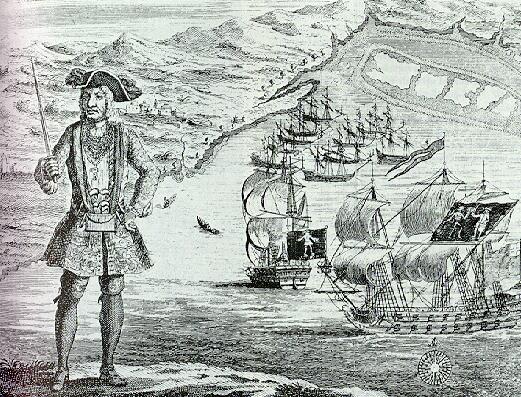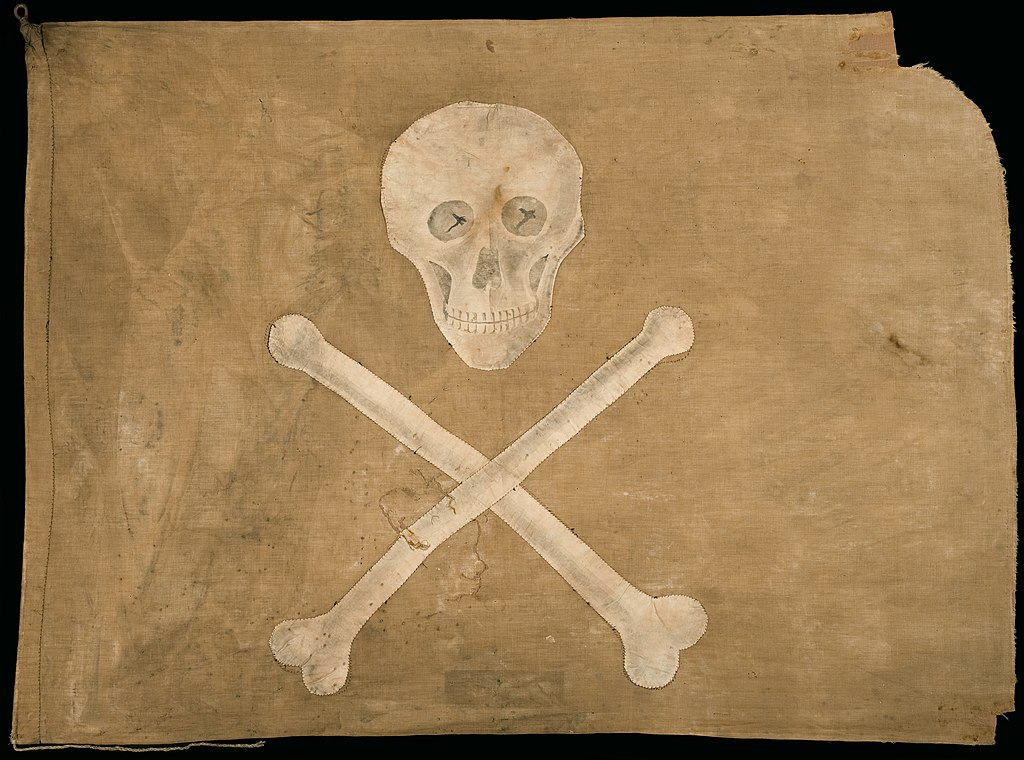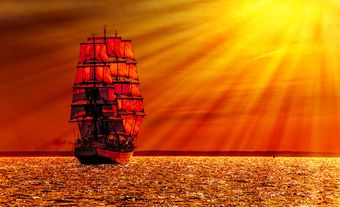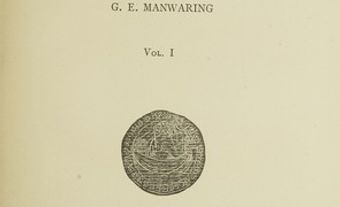Bartholomew Roberts, pirate (born circa 1682 in Pembrokeshire, Wales; died 10 February 1722 in Guinea, West Africa). Nicknamed “Black Bart,” Bartholomew Roberts became a pirate, captaining more than 400 ships off the coasts of Africa, North America and South America, including the Caribbean and Newfoundland and Labrador. Only three years after becoming a pirate, he was killed by a cannon blast in a battle with a British ship off the coast of Guinea.
Early Life
Bartholomew Roberts was born around 1682 in Pembrokeshire, southwest Wales. His parents named him John. His father was a landowner, and he spent his youth helping out with the family farm.
Roberts left home at around age 13 to work aboard ships and is believed to have worked as a merchant seaman. In 1718, he became second mate on Princess of London, which transported enslaved people from the African coast to Britain. (See also Black Enslavement in Canada.) When a pirate ship captained by Howell Davis captured Princess in February 1720, Roberts either volunteered to join the pirates or was kidnapped by them. Davis was killed in a battle with a Portuguese ship off the West African coast.
Despite having been aboard for only six weeks, the crew chose Roberts as their new captain. His first order was to attack the town from which the Portuguese ship had sailed. Roberts left the fort on the Island of Princes badly damaged and the nearby town burned to the ground.
Now a pirate captain, he changed his first name from John to Bartholomew to confuse British authorities. He also became known as Black Bart. The meaning behind this moniker is uncertain, but it might have referred to how his skin tanned and darkened after years at sea. Another theory is that the name refers to Roberts’s ruthlessness as a pirate. After an apparent encounter with a Dutch ship, he ordered its crew members’ ears to be cut off if they did not surrender the information he sought.
Life as a Pirate
To make it clear that his ships belonged to no country, Black Bart created his own flags. One flag consisted of a silhouette of himself standing with a sword astride one skull labelled ABH and another, AMH. The skulls represented the severed heads of the governors of Barbados and Martinique, respectively. The flag might have represented bragging or a warning because on one of his adventures, Roberts had captured Martinique’s governor and hanged him from the yardarm.
He also used a flag with a skull above two crossed bones that became known as the Jolly Roger. Roberts would often fly the flag of a particular country when approaching a ship and then quickly replace it with one of his pirate flags when it was too late for his victims to flee.
To avoid capture, Roberts would order his ships to attack vessels on one coast and then cross the ocean to attack on another coast. For example, in January 1722, he captured an 11-ship fleet off the coast of West Africa. He told the fleet’s captains that he would release them all if he was given a quantity of gold. When one captain refused, Roberts had the captain’s ship burned, killing all aboard, including 80 enslaved people who were being transported to London. He then sailed to the Caribbean’s Leeward Islands, where he learned that the people of a town there had recently attacked and killed pirates. He had several ships in the town’s harbour looted and burned.
Roberts captained many ships that he had stolen, including those he renamed Royal Rover, Fortune and Good Fortune, along with four that he called Royal Fortune. All were large, fast and heavily armed with anywhere from 40 to 50 cannons.
Roberts was a charismatic leader who did not drink alcohol and generously shared stolen loot with his crews. Mutiny on pirate ships was commonplace, but Roberts suffered only one when, in 1720, Walter Kennedy gathered supporters and left with two ships. He was put on trial for piracy in Ireland and hanged a year later.
Did You Know?
Bartholomew Roberts created the image we now associate with pirates. In battle, he wore breeches, a long, bright red waistcoat, a large hat with a red feather, gold chains around his neck and two pistols strapped across his chest.
Black Bart in Newfoundland
Roberts sailed past the coast of Nova Scotia in June 1720. Before dawn on 21 June, his ship, Fortune, approached a fleet of 22 fishing ships at Trepassey, south of St. John’s, Newfoundland and Labrador. As was often the case, Roberts’s large ship, pirate flag, beating drums, blaring trumpets and reputation as a ruthless pirate allowed intimidation rather than cannon fire to bring him victory. The Newfoundland captains and crews abandoned their ships, leaving Roberts and his crew to steal the supplies he needed. It was a safe town to plunder because British naval vessels that were deployed to guard against piracy were at St. John’s and Placentia, leaving Trepassey defenceless. Fully supplied, Roberts then moved south down the coast. After two weeks of raiding and pillaging, he sailed for the Caribbean.
Death
British naval commander Chaloner Ogle was assigned to find and capture Roberts. In February 1722, Ogle’s ship, HMS Swallow, approached Royal Fortune, which was anchored near Cape Lopez, off the coast of Guinea, West Africa. When the two ships came astride each other and began exchanging cannon fire, Roberts was hit in the throat by metal from the grapeshot raining down on his ship. The battle raged for three hours, and the pirates finally surrendered. Before their ship was boarded, the pirates followed their captain’s orders and slipped Roberts’s body into the ocean.
Fifty-two members of his crew were found guilty of piracy and murder and hanged in the world’s largest public execution of pirates in the so-called Golden Age of Piracy. Other crew members were released, and 77 African crew members, whom Roberts had rescued from ships transporting enslaved people, were put back in chains and returned to slavery. Ogle was knighted.
Roberts died after only three years of piracy. He had captured more than 400 ships. Roberts predicted his early demise when he wrote, “No, a merry life and a short one shall be my motto.”

 Share on Facebook
Share on Facebook Share on X
Share on X Share by Email
Share by Email Share on Google Classroom
Share on Google Classroom










